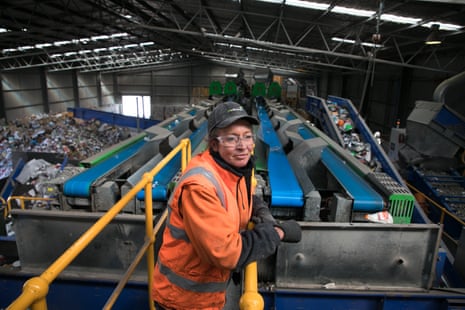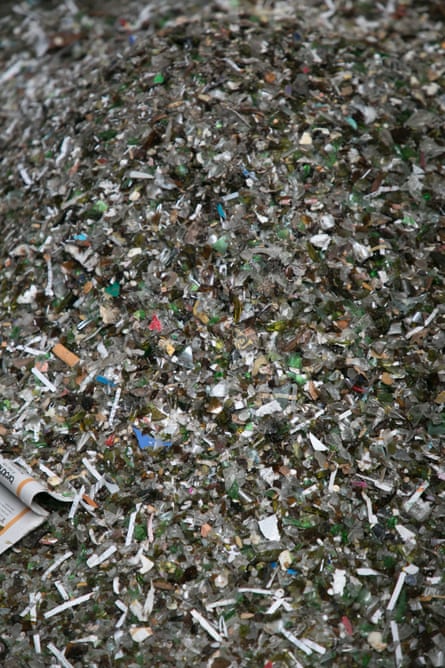The recycling industry has been in crisis mode in Australia since January when China, which previously bought 50% of the recycling we collect, implemented a ban that cut out 99% of what we used to sell.
Recycling companies had relied on this export revenue stream to stay afloat – the amount of waste recycling we create exceeds the demand we have to buy and use within Australia. Without an outlet, some companies began stockpiling recycling or sending it straight to landfill.
Now the industry is in an uneasy state as it moves to fix the problem, and what happens to our waste depends mostly on which bin it ends up in.
High levels of contamination in the commingling yellow bin means much of that recycling cannot be sold to China, and some of it is sent straight to landfill. Conversely, a lot of what goes in our red bin is recyclable. A few facilities attempt to filter and salvage what they can before it heads to landfill.
But the Municipal Association of Victoria says it might take five years for recycling to fully recover – and this is despite a $24m rescue package from the Victorian government. In the meantime, and in other councils around the country, rates may rise, stock may pile up and some recycling will still find its way to landfill.
Guardian Australia visited three different waste processing plants to see what the waste and recycling crisis looks like right now.
The yellow commingled bin
The Hume recycling site, run by Re.Group, services all households in the ACT and those in south-east New South Wales. It receives over 200 tonnes of commingled recycling a day – 50% paper,around 30% glass, less than 10% plastic and metal, and just over 10% of contaminated, or otherwise non-recyclable, material.

- Clockwise from top: A truck unloads recyclable materials, collected in the kerbside yellow bins, at the Hume recycling site in the ACT. Next: Material is transferred from the tipping floor to the pre-sort station, where two workers inspect the incoming material and remove items that are not recyclable or that would damage the plant and equipment.

First it’s sorted by hand to remove hazardous materials such as batteries or cement. It’s then sorted mechanically by size, shape and material property. Broken glass drops out first, then mid-size items such as aluminium cans, and then paper and cardboard.



- Clockwise from top: Hazel Waddell in front of the container processing line. An optical sorting system identifies each container and uses jets or air to sort it into a bunker for either PET (for example soft drink bottles), HDPE coloured (for example flavoured milk bottles), HDPE natural (for example milk bottles), or mixed plastic. Metallic items with iron in them are recovered using magnets, while those without iron are recovered using electrical separators. Next: ballistic separators and conveyors are used to separate rolling material from flat material.

More than 90% of what the Hume facility receives makes its way back to Australian recyclers. For instance, every month, it creates 1,200 tonnes of glass sand, which can be used in construction or remade into glass bottles.



The red waste bin
The Global Renewables facility in Eastern Creek, in Western Sydney, receives 10% of Sydney’s red bin waste – which is around 600 tonnes a day. Workers attempt to salvage and recycle as much of this as possible, and around 70% of what is dropped off is diverted away from landfill. But in the majority of local councils, the red bin doesn’t makes it to a plant like this and heads instead straight to landfill.

- Clockwise from top: Abu Kamaras’s role is to load the material from the tipping floor and feed it into the processing plant. Next: the Eastern Creek facility processes 220,000 tonnes per year of mixed waste from Sydney households.

About 60% is turned into compost. All the organic material, kitchen and food waste becomes a fine, nutrient powder that is sold to farms. Around 5% is retrieved and recycled – and what isn’t recyclable or compostable is sent to landfill.

- A 200-metre composting hall
Material spends at least two weeks inside the composting hall, where rotating devices slowly turn it and move it across the bay. The composting process is run by controlling moisture and air levels, reaching temperatures above 55C.




- Clockwise from top: Material inside the composting hall, an engineered biofilter that destroys odour, composted organic material, material which has been identified as recycling
That leftover waste – around 30% of the total received – ends up at the tip.


The green waste bin
Most of Shellharbour’s food and garden organics go to Re.Group’s enclosed composting facility at Dunmore. Here, it is transformed into compost products that can be used by both commercial operators and households.
About 99% of what goes into the green bin is turned into compost. Because it is already separated at the source and cleaner, this compost ishigher quality than the compost made from red bin food scraps. Green bin compost can be given back to local households to use in their gardens. According to the 2016 National Waste Survey, Australians generate 13 million tonnes of organic waste a year, and most of it is recycled through composting.


- Left to right: The enclosed composting facility, a front end loader is used to feed the food organics and garden organics into the system

Most green bins operate by the same broad rules: it’s a place for prunings, cuttings, small branches and grass. However, every council is different and some, like Perth’s Melville council, allow additional organic material, such as meat and dairy, coffee grounds and dog faeces, into the green bins.



- Above: Pat Keating, the site manager at Shellharbour’s composting facility


- Different stages of the composting process.
Garth Lamb, a spokesman for Re.Group, says it’s up to each community to use green bins properly and to understand what can and can’t go in them. For most councils, soil and rocks, large branches and hazardous organic waste must be separated out.
